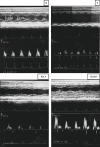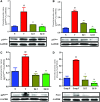Beneficial effects of edaravone, a novel antioxidant, in rats with dilated cardiomyopathy
- PMID: 22268705
- PMCID: PMC3822987
- DOI: 10.1111/j.1582-4934.2012.01526.x
Beneficial effects of edaravone, a novel antioxidant, in rats with dilated cardiomyopathy
Abstract
Edaravone, a novel antioxidant, acts by trapping hydroxyl radicals, quenching active oxygen and so on. Its cardioprotective activity against experimental autoimmune myocarditis (EAM) was reported. Nevertheless, it remains to be determined whether edaravone protects against cardiac remodelling in dilated cardiomyopathy (DCM). The present study was undertaken to assess whether edaravone attenuates myocardial fibrosis, and examine the effect of edaravone on cardiac function in rats with DCM after EAM. Rat model of EAM was prepared by injection with porcine cardiac myosin 28 days after immunization, we administered edaravone intraperitoneally at 3 and 10 mg/kg/day to rats for 28 days. The results were compared with vehicle-treated rats with DCM. Cardiac function, by haemodynamic and echocardiographic study and histopathology were performed. Left ventricular (LV) expression of NADPH oxidase subunits (p47(phox), p67(phox), gp91(phox) and Nox4), fibrosis markers (TGF-β(1) and OPN), endoplasmic reticulum (ER) stress markers (GRP78 and GADD 153) and apoptosis markers (cytochrome C and caspase-3) were measured by Western blotting. Edaravone-treated DCM rats showed better cardiac function compared with those of the vehicle-treated rats. In addition, LV expressions of NADPH oxidase subunits levels were significantly down-regulated in edaravone-treated rats. Furthermore, the number of collagen-III positive cells in the myocardium of edaravone-treated rats was lower compared with those of the vehicle-treated rats. Our results suggest that edaravone ameliorated the progression of DCM by modulating oxidative and ER stress-mediated myocardial apoptosis and fibrosis.
© 2012 The Authors Journal of Cellular and Molecular Medicine © 2012 Foundation for Cellular and Molecular Medicine/Blackwell Publishing Ltd.
Figures





Similar articles
-
The antioxidant edaravone attenuates ER-stress-mediated cardiac apoptosis and dysfunction in rats with autoimmune myocarditis.Free Radic Res. 2010 Sep;44(9):1082-90. doi: 10.3109/10715762.2010.499904. Free Radic Res. 2010. PMID: 20815771
-
Quercetin offers cardioprotection against progression of experimental autoimmune myocarditis by suppression of oxidative and endoplasmic reticulum stress via endothelin-1/MAPK signalling.Free Radic Res. 2012 Feb;46(2):154-63. doi: 10.3109/10715762.2011.647010. Epub 2012 Jan 23. Free Radic Res. 2012. PMID: 22145946
-
Involvement of AMPK and MAPK signaling during the progression of experimental autoimmune myocarditis in rats and its blockade using a novel antioxidant.Exp Mol Pathol. 2012 Oct;93(2):183-9. doi: 10.1016/j.yexmp.2012.04.012. Epub 2012 Apr 18. Exp Mol Pathol. 2012. PMID: 22542793
-
Regulation of inflammation and myocardial fibrosis in experimental autoimmune myocarditis.Inflamm Allergy Drug Targets. 2011 Jun;10(3):218-25. doi: 10.2174/187152811795564091. Inflamm Allergy Drug Targets. 2011. PMID: 21495969 Review.
-
Clinical implications of anti-heart autoantibodies in myocarditis and dilated cardiomyopathy.Autoimmunity. 2008 Feb;41(1):35-45. doi: 10.1080/08916930701619235. Autoimmunity. 2008. PMID: 18176863 Review.
Cited by
-
The efficacy of edaravone (radicut), a free radical scavenger, for cardiovascular disease.Int J Mol Sci. 2013 Jul 4;14(7):13909-30. doi: 10.3390/ijms140713909. Int J Mol Sci. 2013. PMID: 23880849 Free PMC article. Review.
-
Edaravone inhibits pressure overload-induced cardiac fibrosis and dysfunction by reducing expression of angiotensin II AT1 receptor.Drug Des Devel Ther. 2017 Oct 16;11:3019-3033. doi: 10.2147/DDDT.S144807. eCollection 2017. Drug Des Devel Ther. 2017. PMID: 29081650 Free PMC article.
-
Sitagliptin ameliorates diabetic nephropathy by blocking TGF-β1/Smad signaling pathway.Int J Mol Med. 2018 May;41(5):2784-2792. doi: 10.3892/ijmm.2018.3504. Epub 2018 Feb 16. Int J Mol Med. 2018. PMID: 29484381 Free PMC article.
-
Human umbilical cord mesenchymal stem cells alleviate acute myocarditis by modulating endoplasmic reticulum stress and extracellular signal regulated 1/2-mediated apoptosis.Mol Med Rep. 2017 Jun;15(6):3515-3520. doi: 10.3892/mmr.2017.6454. Epub 2017 Apr 11. Mol Med Rep. 2017. PMID: 28440472 Free PMC article.
-
Endoplasmic reticulum stress induces different molecular structural alterations in human dilated and ischemic cardiomyopathy.PLoS One. 2014 Sep 16;9(9):e107635. doi: 10.1371/journal.pone.0107635. eCollection 2014. PLoS One. 2014. PMID: 25226522 Free PMC article.
References
-
- Kawai C. From myocarditis to cardiomyopathy: mechanisms of inflammation and cell death. Circulation. 2001;34:199–204. - PubMed
-
- Kodama M, Hanawa H, Saeki M, et al. Rat dilated cardiomyopathy after autoimmune giant cell myocarditis. Circ Res. 1994;75:278–84. - PubMed
-
- Okura Y, Yamamoto T, Goto S, et al. Characterization of cytokine and iNOS mRNA expression in situ during the course of experimental autoimmune myocarditis in rats. J Mol Cell Cardiol. 1997;29:491–502. - PubMed
-
- Ishiyama S, Hiroe M, Nishikawa T, et al. The Fas/Fas ligand system is involved in the pathogenesis of autoimmune myocarditis in rats. J Immunol. 1998;161:4695–701. - PubMed
-
- Ishiyama S, Hiroe M, Nishikawa T, et al. Nitric oxide contributes the progression of myocardial damage in experimental autoimmune myocarditis in rats. Circulation. 1997;95:489–96. - PubMed
Publication types
MeSH terms
Substances
LinkOut - more resources
Full Text Sources
Medical
Research Materials
Miscellaneous

